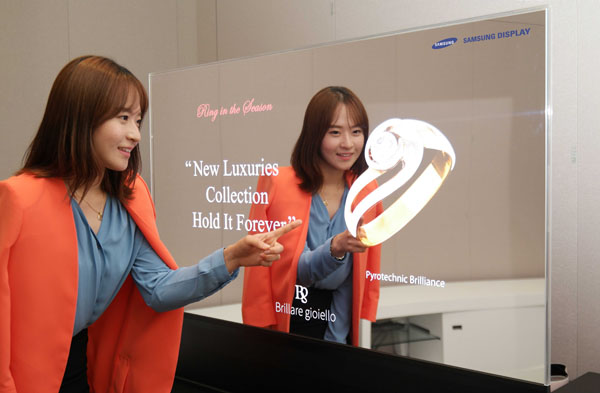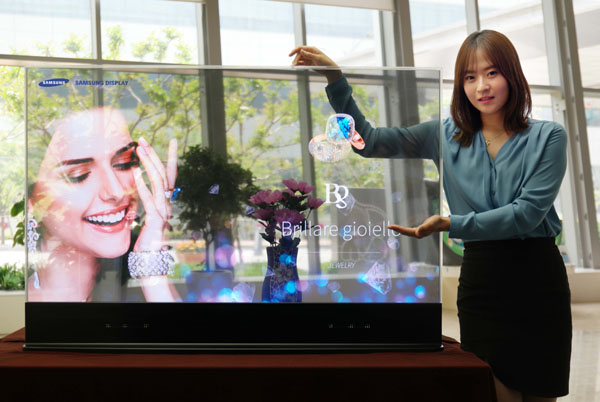Samsung Introduces Mirrored And Transparent OLED Display Panels That Use Intel RealSense Tech
You've heard about 3D interactive displays, mirrored displays and OLED displays, but at the Retail Asia Expo in Hong Kong, Samsung showed the first product that combines all three technologies into a single interactive experience.
LCDs with a mirrored front layer are nothing new, but this is the first time we've seen an OLED panel thus equipped. With OLED's superior contrast, color reproduction and viewing angles, it's the ideal technology for commercial applications that require a bright image viewable by many people at once.
By applying a mirrored finish to the panel, a customer can see themselves and the on-screen image at the same time. Imagine trying on virtual clothing or jewelry without entering a dressing room. Using Intel RealSense technology, Samsung's new display can manipulate and move the image to match the user's movements.
The panel has a reflectance level greater than 75 percent, which is 50 percent higher than competing LCD products. It also renders 100 percent of the NTSC color gamut and claims a 100,000:1 contrast ratio. Much of this is possible thanks to OLED technology, which doesn't require a backlight because each pixel is self-illuminating. Panel response is less than one millisecond, which means there is no perceptible motion blur, and input lag is low enough to enable perfectly-synchronized tracking of onscreen movement to that of the user.
Potential applications for the mirrored display include the retail marketplace, and even in the home as a dressing mirror that can provide information to the user based on their personal preferences.
Samsung has also incorporated OLED technology and Intel RealSense into a transparent panel.
One of the biggest design challenges for transparent display panels is light transmittance. LCDs require a backlight that severely reduces the amount of ambient light that can get through from back to front. That means objects placed behind the screen must be brightly lit in order to be seen. Some products block as much as 90 percent of the light behind them.
Get Tom's Hardware's best news and in-depth reviews, straight to your inbox.
An OLED panel's self-illuminating pixel structure allows 45 percent of the available light to get through from behind the display. That makes it much easier to properly balance light levels between the physical and virtual objects being shown. Samsung also renders 100 percent of the NTSC color gamut and adds higher contrast and a much faster response time to make onscreen motion fluid and free of blur or stutter.
With a transparent panel, objects from small jewelry to automobiles can be shown behind a sign that changes depending on user interaction. OLED's better viewing angles allow the images to be seen by more people simultaneously.
It seems that we're getting closer to the futuristic worlds shown in movies like Minority Report. Displays that interact with users in real time can provide context-sensitive information in new and interesting ways. With displays that react to our movements, can retinal scanners be far behind?
Follow us @tomshardware, on Facebook and on Google+.

Christian Eberle is a Contributing Editor for Tom's Hardware US. He's a veteran reviewer of A/V equipment, specializing in monitors. Christian began his obsession with tech when he built his first PC in 1991, a 286 running DOS 3.0 at a blazing 12MHz. In 2006, he undertook training from the Imaging Science Foundation in video calibration and testing and thus started a passion for precise imaging that persists to this day. He is also a professional musician with a degree from the New England Conservatory as a classical bassoonist which he used to good effect as a performer with the West Point Army Band from 1987 to 2013. He enjoys watching movies and listening to high-end audio in his custom-built home theater and can be seen riding trails near his home on a race-ready ICE VTX recumbent trike. Christian enjoys the endless summer in Florida where he lives with his wife and Chihuahua and plays with orchestras around the state.
-
InvalidError OLEDs will enable all kinds of neat stuff in the future. I only wish the prices would come down faster.Reply
When the OLED hype started ramping up nearly 10 years ago, expectations were that it would enable inexpensive large format, ultra-thin, high definition displays with super-fast response time, basically the ultimate display technology. OLED has met nearly all of those expectations, except for the price where it shows no sign of becoming affordable in the foreseeable future. -
stevenrix Off Topics: the amount of ads on Tomshardware is beyond unthinkable, after more than 1 decade spent here, it's taking me more and more time to open a single page on IE than reading it. I will be reading less and less of TH if this issue can't be fixed. Surfing on the Internet should not be torture.Reply
-
danlw @InvalidErrorReply
Actually, there are good signs. When Sony introduced their 11" OLED tv, it was $2,500. Now, you can get an LG 55EC9300 55" OLED on Amazon for $2500. So prices are definitely moving down. -
lun471k ReplyOff Topics: the amount of ads on Tomshardware is beyond unthinkable, after more than 1 decade spent here, it's taking me more and more time to open a single page on IE than reading it. I will be reading less and less of TH if this issue can't be fixed. Surfing on the Internet should not be torture.
You are totally free to look for utilities like Adblock Plus and whitelist ads that are actualy useful/help the website without letting annoying ones go through.
------------
I can't wait to see where OLED tech will lead us in the near future. This is awesome.
-
PaulBags This is absolutely amazing and I love it.Reply
Still waiting for the foldable OLED screens that can go from wristwatch to phone to full tablet :p. But wow, there's going to be some amazing OLED prodicts in the mean time, like these. -
rdc85 Have they tackle the short lifetime problems...???Reply
It's still no sense for me to buy monitor/tv that only have "best before" time 2-3 years...
edit: I know they using run about ways by increasing the size of blue one..
(the one fastest degenerate), that doesn't change fact after few years it'll start dimmer
-
fuzzion Have to agree that we will see large commercial application by 2020 and large consumer use by 2025Reply -
eza "With displays that react to our movements, can retinal scanners be far behind?"Reply
I'm pretty sure that retinal scanners already exist ;-)
This display tech looks amazing. I wonder how much these will cost?

